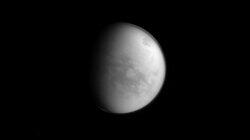The Sky at Night - Season 49 / Year 2005

Season 49 / Year 2005

Episodes

Lord of the Rings
The American and European spacecraft Cassini has been at Saturn now for six months. It has sent back fabulous images of the planet, its complex rings and many moons including the mysterious Titan. Patrick Moore discusses this and Cassini's probe Huygens, which will be sent to Titan on Christmas Day.

Unveiling Titan
We have seen the surface of Titan, Saturn's moon and one of the most mysterious solar system bodies. Patrick Moore talks to the lead scientist of the Huygens surface science package (SSP), Professor John Zarnecki, about the first results from the probe. (2005)

Strangers in the Night
Comets are thought to come from the Kuiper Belt beyond Pluto and the Oort Cloud at the very edge of our solar system. Little is known about this dark, far away home for comets. Patrick Moore debates the mysterious belts and the wandering strangers which escape from them. Also, the latest news from Mars, Saturn and the farthest regions of our Universe.

Star Party
For the first time ever, Sir Patrick Moore has hosted a star party at his house in Selsey. Over two nights, amateur astronomers played lottery with the weather. Clouds, rain and fog played havoc with the viewing, but at last the night sky was revealed in all its glory.

Eye on the Universe
In its 15 years, the Hubble Space Telescope has revolutionised astronomy with it's amazing insight into our Universe. Patrick Moore talks to Professor Gerry Gilmore about its highs and lows.Chris Lintott reports from the National Astronomy Meeting about the lastest finding on our Universe.

The Shocking Sun
Sun spots and solar flares release high energy particles and radiation that can damage satellites and telecommunications, as well as creating the beautiful aurora in the atmosphere. Patrick Moore talks to Scottish astronomer Professor John Brown about the lastest solar mission, Rhessi, which is observing these incredibly violent outbursts from our nearest star, the Sun.

Deep Impact
NASA are sending a probe into the comet 9P/ Tempel-1, early on the morning of 4 July 2005. This is a unique event, from which they hope to find out how comets are made. Are they balls of ice and mud, the harbourers of life's components, or just solid rocks of sterile cosmic debris? The Deep Impact programme hopes to provide the answers, but this destructive act is not without its critics. The Sky at Night explores the pros and cons of hitting a comet.

Fallout From Deep Impact
On 4 July NASA hopes to send an impactor into the comet 9P/Tempel-1. Patrick Moore talks to the world's leading comet experts about the fallout from this destructive act. Chris Lintott reports from Palomar Observatory in California, where astronomers will be eagerly watching the comet to see what happens when Deep Impact hits its mark.

The Search for Life
The search for life elsewhere in our Universe has long been the Holy Grail for astronomers. Planets around distant stars have recently been discovered and we now realise that solar systems like our own could be widespread. So is life on Earth unique? With missions to Mars, Saturn's moon Titan and Jupiter's moon Europa, we could be nearing an answer. No definitive traces of life have been found elsewhere, but astronomers are probing ever deeper on our nearest planetary neighbours and across our Universe for the signitures of life. Patrick Moore discusses the issue with Professor Monica Gardy and Professor Simon Conway Morris.Chris Lintott spends a night meteor-watching with Dr John Mason, Martin Mobberly and Martin Andrews. Every year the Earth passes through dusty tail remnants of the comet Swift-Tuttle. These enter Earth's atmosphere-forming meteor showers called the perseids, this year they are at their maximum in mid-August.

Mapping The Sky (Sky Survey)
Man is scanning the night sky and counting stars, galaxies and other solar bodies. Patrick Moore discusses two of the most comprehensive surveys - 2dF and the Sloan Digital Sky Survey - and asks what they tells us about our Universe. Chris Lintott visits the Palomar Observatory in Southern California. Patrck also ventgures into his gardne to look at the Perseids.

The Planets (Converge On Cambridge)
Its been an incredible year for the planets, with amazing discoveries and startling new insights into our Solar System. Earlier this month, astronomers from around the World converged on Cambridge to discuss the latest planetary research. Chris Lintott reports.

Mars and the Ring of Fire
Mars is almost as close as it can get to Earth and better placed than it will be for many years. Patrick Moore throws a Mars party in his back garden to enjoy the exceptional views of the red planet. Chris Lintott reports from Madrid, where he witnessed the dramatic annular eclipse, also called 'the ring of fire'.

Celestial Zoo
Our Sun is an ordinary star, but the celestial zoo contains stars as small as the Earth and others which are tens of thousands of times brighter. Patrick Moore takes a census and celebrates the tenth anniversary of the solar satellite Soho, which has produced spectacular images of flares, comets and sunspots the size of planets.
Recently Updated Shows

NCIS
NCIS (Naval Criminal Investigative Service) is more than just an action drama. With liberal doses of humor, it's a show that focuses on the sometimes complex and always amusing dynamics of a team forced to work together in high-stress situations. Leroy Jethro Gibbs, a former Marine gunnery sergeant, whose skills as an investigator are unmatched, leads this troupe of colorful personalities. Rounding out the team are Anthony DiNozzo, an ex-homicide detective whose instincts in the field are unparalleled and whose quick wit and humorous take on life make him a team favorite; the youthful and energetic forensic specialist Abby Sciuto, a talented scientist whose sharp mind matches her Goth style and eclectic tastes; Caitlin Todd, an ex-Secret Service Agent; and Timothy McGee, an MIT graduate whose brilliance with computers far overshadows his insecurities in the field; Assisting the team is medical examiner Dr. Donald "Ducky" Mallard, who knows it all because he's seen it all, and he's not afraid to let you know. From murder and espionage to terrorism and stolen submarines, these special agents travel the globe to investigate all crimes with Navy or Marine Corps ties.

The Americas
The Americas showcases the wonders, secrets and fragilities of the world's greatest supercontinent. For the first time, the Americas stars in its own incomparable series, using cutting-edge technology to uncover never-before-seen behavior, and highlight the extraordinary, untold wildlife stories that will deeply connect with millions around the world. Five years in the making and filmed over 180 expeditions, this groundbreaking series reveals the spectacular landscapes of Earth's most varied landmass - the only one to stretch between both poles. The Americas' unprecedented scale and ambition delivers remarkable world firsts; new species, new intimate courtship, dramatic deep sea hunting and some of nature's strangest stories - even a frog that seems to defy death every day. Each hourlong episode features a different iconic location across the Americas: "The Atlantic Coast," "Mexico," "The Wild West," "The Amazon," "The Frozen North," "The Gulf Coast," "The Andes," "The Caribbean," "The West Coast" and "Patagonia."

Peacemaker
The series will explore the origins of the Peacemaker, a man who believes in peace at any cost - no matter how many people he has to kill to get it.

